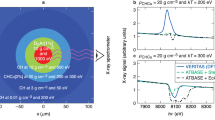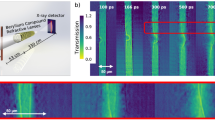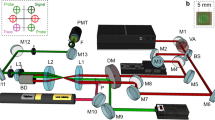Abstract
Petawatt lasers can generate extreme states of matter, making them unique tools for high-energy-density physics. Pressures in the gigabar regime can potentially be generated with cone-wire targets when the coupling efficiency is high and temperatures reach 2–4 keV (ref. 1). The only other method of obtaining such gigantic pressures is to use the megajoule laser facilities being constructed (National Ignition Facility and Laser MégaJoule). The energy can be transported over surprisingly long distances but, until now, the guiding mechanism has remained unclear. Here, we present the first definitive experimental proof that the heating is maximized close to the wire surface, by comparison of interferometric measurements with hydrodynamic simulations. New hybrid particle-in-cell simulations show the complex field structures for the first time, including a reversal of the magnetic field on the inside of the wire. This increases the return current in a spatially separated thin layer below the wire surface, resulting in the enhanced level of ohmic heating. There are a significant number of applications in high-energy-density science, ranging from equation-of-state studies to bright, hard X-ray sources, that will benefit from this new understanding of energy transport.
This is a preview of subscription content, access via your institution
Access options
Subscribe to this journal
Receive 12 print issues and online access
$259.00 per year
only $21.58 per issue
Buy this article
- Purchase on SpringerLink
- Instant access to full article PDF
Prices may be subject to local taxes which are calculated during checkout




Similar content being viewed by others
References
Kodama, R. et al. Plasma devices to guide and collimate a high density of MeV electrons. Nature 432, 1005–1008 (2004).
Kodama, R. et al. Fast heating of ultrahigh-density plasma as a step towards laser fusion ignition. Nature 412, 798–802 (2001).
Kodama, R. et al. Nuclear fusion—fast heating scalable to laser fusion ignition. Nature 418, 933–934 (2002).
Tabak, M. et al. Ignition and high gain with ultrapowerful lasers. Phys. Plasmas 1, 1626–1634 (1994).
Norreys, P. A. et al. Experimental studies of the advanced fast ignitor scheme. Phys. Plasmas 7, 3721–3726 (2000).
Gremillet, L., Bonnaud, G. & Amiranoff, F. Filamented transport of laser generated relativistic electrons penetrating a solid target. Phys. Plasmas 9, 941–948 (2002).
Silva, L. O., Fonseca, R. A., Tonge, J. W., Mori, W. B. & Dawson, J. M. On the role of the purely transverse Weibel instability in fast ignitor scenarios. Phys. Plasmas 9, 2458–2461 (2002).
Tatarakis, M. et al. Propagation instabilities of high intensity laser-produced electron beams. Phys. Rev. Lett. 90, 175001 (2003).
Wei, M. S. et al. Observations of the filamentation of high intensity laser-produced electron beams. Phys. Rev. E 70, 056412 (2004).
Bret, A., Firpo, M. C. & Deutsch, C. Characterisation of the initial filamentation of a relativistic electron beam passing through a plasma. Phys. Rev. Lett. 94, 115002 (2005).
Jung, R. et al. Study of electron beam propagation through pre-ionized dense foam plasmas. Phys. Rev. Lett. 94, 195001 (2005).
Lancaster, K. L. et al. Measurements of energy transport patterns in solid density laser plasma interactions at intensities of 5×1020 W cm−2. Phys. Rev. Lett. 98, 125002 (2007).
Key, M. H. et al. Study of electron and proton isochoric heating for fast ignition. J. Physique IV 133, 371–378 (2006).
Gregory, C. Astrophysical Jet Experiments with Laser-Produced Plasmas. Thesis, Univ. of York (2007).
Dribinski, V et al. Reconstruction of abel-transformable images: The Gaussian basis-set expansion abel transform method. Rev. Sci. Instrum. 73, 2634–2642 (2002).
Christiansen, J. P., Ashby, D. E. T. F. & Roberts, K. V. MEDUSA—one-dimensional laser fusion code. Comp. Phys. Comm. 7, 271–287 (1974).
MacFarlane, J. J., Golovkin, I. E. & Woodruff, P. R. HELIOS-CR—A 1-D radiation-magnetohydrodynamics code with inline atomic kinetics modeling. J. Quant. Spectrosc. Radiat. Transfer 99, 381–397 (2006).
Yates, M. A. et al. Experimental-evidence for self-generated magnetic-fields and remote energy deposition in laser-irradiated targets. Phys. Rev. Lett. 49, 1702–1704 (1982).
Amiranoff, F. et al. The evolution of two-dimensional effects in fast-electron transport from high-intensity laser plasma interactions. J. Phys. D 15, 2463–2468 (1982).
Forslund, D. W. & Brackbill, J. U. Magnetic-field-induced surface transport on laser-irradiated foils. Phys. Rev. Lett. 48, 1614–1617 (1982).
Fabbro, R. & Mora, P. Hot-electrons behavior in laser-plane target experiments. Phys. Lett. A 90, 48–50 (1982).
Welch, D. R., Rose, D. V., Oliver, B. V. & Clark, R. E. Simulation techniques for heavy ion fusion chamber transport. Nucl. Instrum. Methods Phys. Res. A 464, 134–139 (2001).
Bell, A. R., Robinson, A. P. L., Sherlock, M., Kingham, R. J. & Rozmus, W. Fast electron transport in laser-produced plasmas and the KALOS code for solution of the Vlasov–Fokker–Planck equation. Plasma Phys. Control. Fusion 48, R37–R57 (2006).
Jackson, J. D. Classical Electrodynamics Ch. 5, 219–221 (Wiley, Hoboken, 1999).
Baton, S. et al. Recent experiments on electron transport in high intensity laser matter interaction. Plasma Phys. Control. Fusion 47, B777–B789 (2005).
Danson, C. N. et al. Vulcan Petawatt—an ultrahigh interaction facility. Nucl. Fusion 44, S239–S246 (2004).
Benattar, R., Popovics, C. & Sigel, R. Polarized-light interferometer for laser fusion studies. Rev. Sci. Instrum. 50, 1583–1585 (1979).
Acknowledgements
This work was supported by the UK Engineering and Physical Sciences Research Council and the Science and Technology Facilities Council. American colleagues acknowledge support from the US Department of energy contract number W-7405-Eng-48. Japanese colleagues acknowledge the Japan Society for the Promotion of Science. The authors gratefully acknowledge the support of the staff of the Central Laser Facility.
Author information
Authors and Affiliations
Contributions
F.N.B., R.R.F., J.S.G., M.H.K., R.K., K.L.L., P.A.N., R.S. and L.V.W. were all involved in project planning. J.S.G. and P.A.N. carried out the data analysis and wrote the letter. All other named authors contributed to the experimental work and corrected the manuscript.
Corresponding author
Supplementary information
Rights and permissions
About this article
Cite this article
Green, J., Lancaster, K., Akli, K. et al. Surface heating of wire plasmas using laser-irradiated cone geometries. Nature Phys 3, 853–856 (2007). https://doi.org/10.1038/nphys755
Received:
Accepted:
Published:
Issue date:
DOI: https://doi.org/10.1038/nphys755
This article is cited by
-
Focusing of short-pulse high-intensity laser-accelerated proton beams
Nature Physics (2012)
-
Characteristics and geometry optimization of a hollow cone for guiding and focusing laser light
Science China Physics, Mechanics and Astronomy (2012)
-
Fast electrons on a wire
Nature Physics (2007)



